Amasty Advanced Reports for Magento 2 and 1
We have already mentioned that the default reporting system of Magento lacks lots of essential features. That’s why it is always better to replace it with a third-party solution, such as Advanced Reports by Amasty, aheadWorks, or Mirasvit. We have already reviewed the last two modules, so it’s time to shed light on the Amasty’s Magento 2 reports extension. Below, you can find a full description of its core features and an overview of report types.

The Amasty Advanced Reports Magento 2 extension radically expands the default reporting functionality by adding top-notch analytic tools and features. After installing the module, you will be able to get stats related to your sales, customers, and catalog. The collected data is vital for making a successful marketing strategy. Of course, it is still possible to use default reports, but they will never provide enough information, and even the smallest lack of data can become a reason for failure. So, what are the core features of Amasty Advanced Reports?
Features
- 20+ report types divided into Sales, Catalog, and Customers groups;
- Informative dashboard with customizable stats display;
- A separate tab on the dashboard showing key data statistics cor the current day;
- Display of the reports data in interactive charts built using the amCharts library;
- Customizable graphs and data grids;
- Possibility to save graphs as a png, jpg, svg, or pdf file;
- Automatic generation of an unlimited number of custom reports based on the created rules;
- Flexible filtering of the reports’ data;
- Export of reports data export to a CSV or XML file.
First of all, it is the availability of over 20 detailed reports related to the mentioned above groups of data (sales, customers, and catalog). Next, you get a highly informative dashboard that helps you understand how your ecommerce business grows, and where it has ups and downs. Note that each report type supports filtering, so you can quickly get the most precise data related to the specified indicators. All graphs and grids are highly customizable and provide the highest possible flexibility of the displayed information. You can easily hide columns that do not provide the information you need.
Before describing each report type, let’s look at how they are divided into groups. The Sales group includes the following reports:
- Sales Overview
- Sales Comparison
- Orders report
- Sales by:
- hour
- day of week
- payment type
- customer group
- country
- state
- coupon
- category
- cart price rules
As for Customers reports, they include Customers report and three more unique report types – New vs. Returning Customers, Abandoned Carts, and Conversion Rate.
Catalog, or Products, reports consist of the Bestsellers, Sales by Product, Sales by Product Attributes, Sales by Brands, and Product Performance reports.
Furthermore, you can create custom reports by setting rule conditions based on various product attributes. This way, you can display sales statistics only for the items with appropriate attributes, like brand, color, size, gender, material, category, etc. For example, you can create a report with a custom selection of products on sale or new arrivals that will be generated automatically.
We also want to say a few words about filtering options. The Magento 2 reports extension by Amasty allows you to filter stats by the quantity of sold products, grand total, time interval, order status, store view, and other parameters. You can feel free to combine them to get more precise information.
It is also necessary to mention that the Magento 2 reports extension supports data export. Consequently, you can use it outside your Magento backend. Both CSV and XML formats are supported.
Backend
Visualization of your store statistics is represented on the dashboard that consists of a few blocks. The dashboard is highly customizable and lets users fine-tune its look to view the stats for particular parameters during the specified period.
The top left block of the Dashboard screen includes two tabs: Total Overview and Today & Live. The first tab shows a total overview of the parameters selected from the available options: Orders, Sales, Average Order Value, Customers, Items Ordered, Refunded, and Abandoned Cart. By clicking the “Detail” button, you will open a dedicated page of the relevant report statistics.
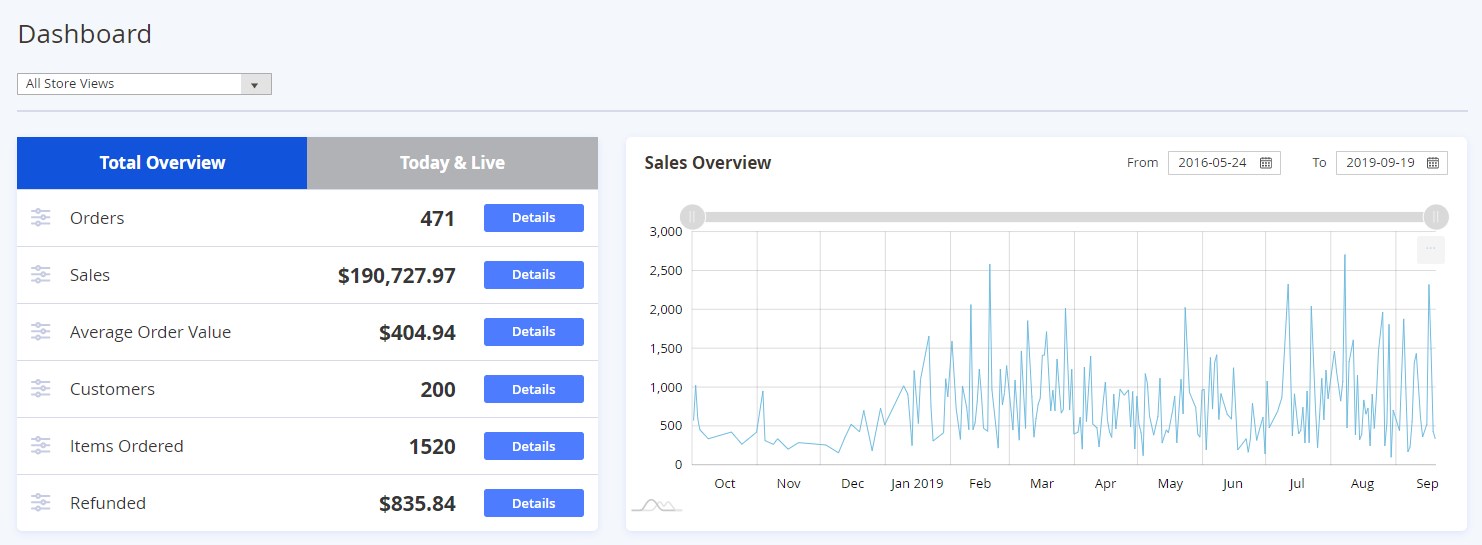
The Today & Live tab shows current statistics on the number of purchased products, placed orders, unique visitors, active shopping carts, and qty of items added to the cart, as well as revenue value. The Sales Overview block lets you check the sales statistics during the set time interval.
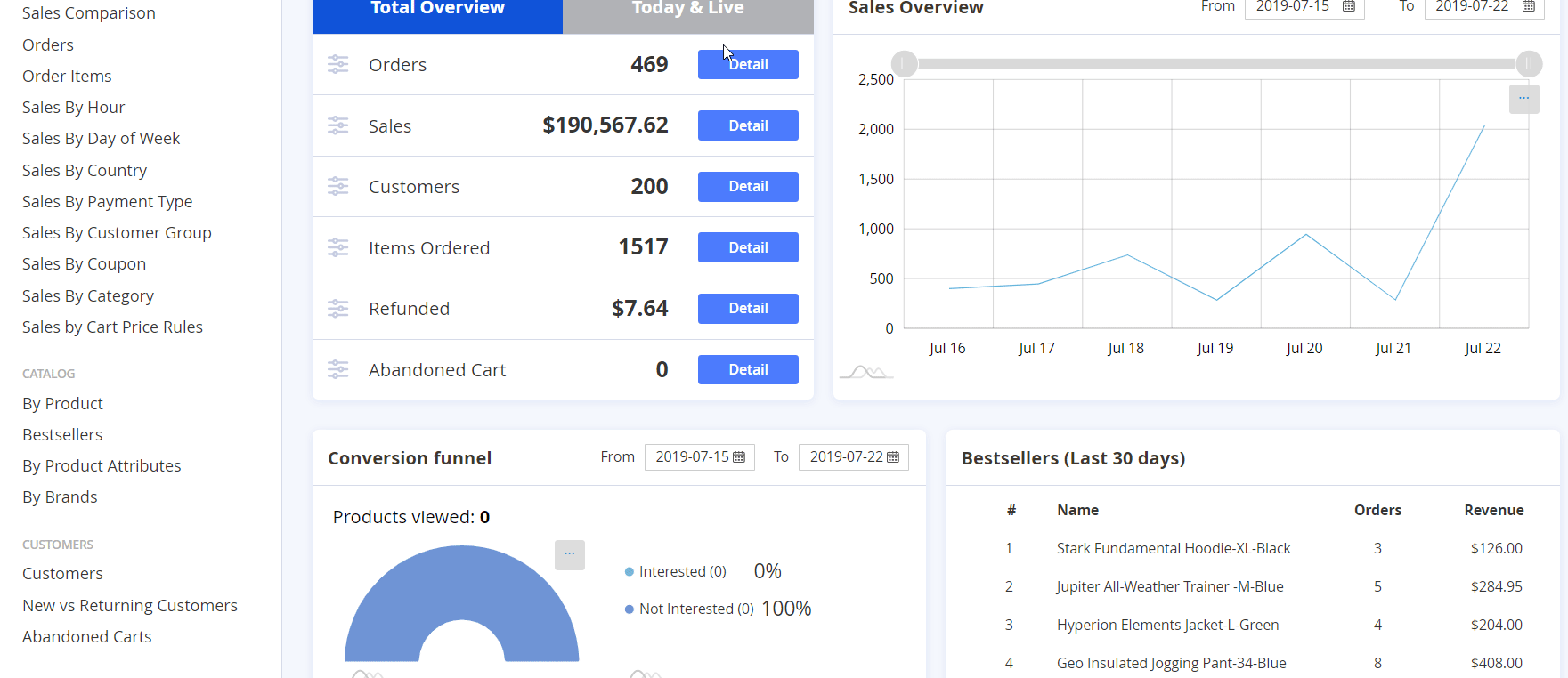
Below, there is a Conversion funnel block that displays data for the selected period. The advanced reports dashboard also generates a list of bestselling products for the last 30 days.
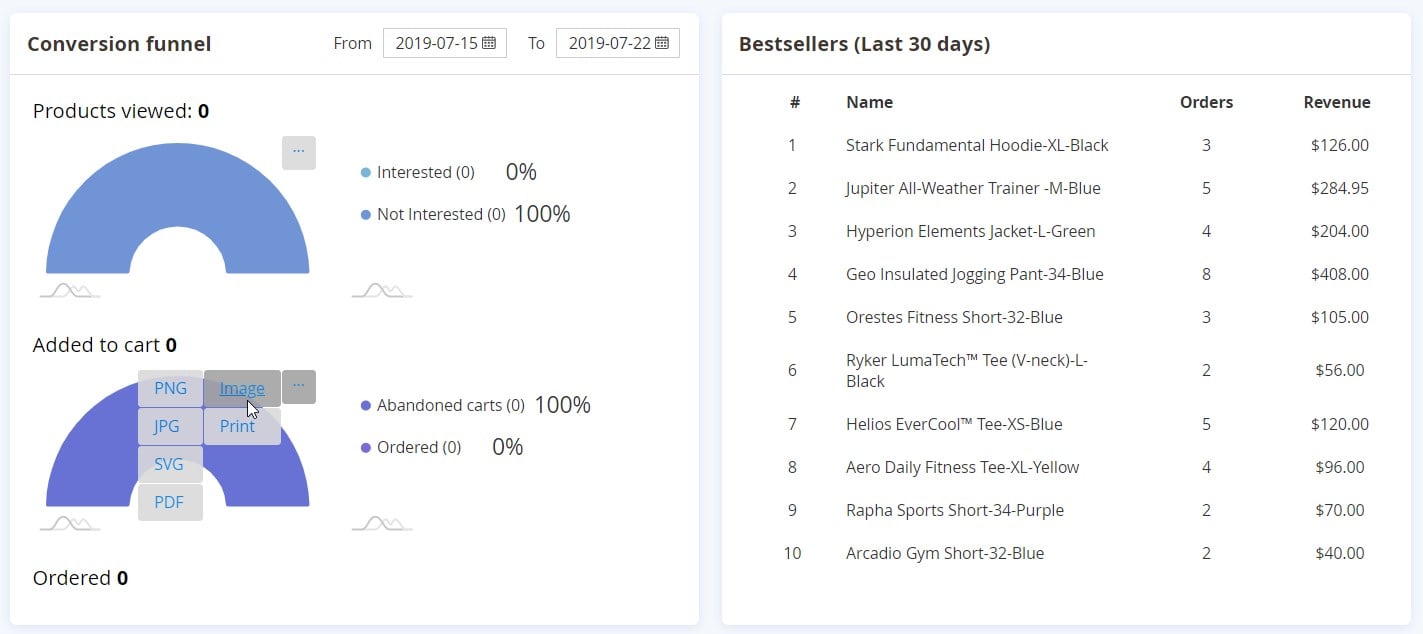
Besides, you can view details of the latest orders in the separate grid.
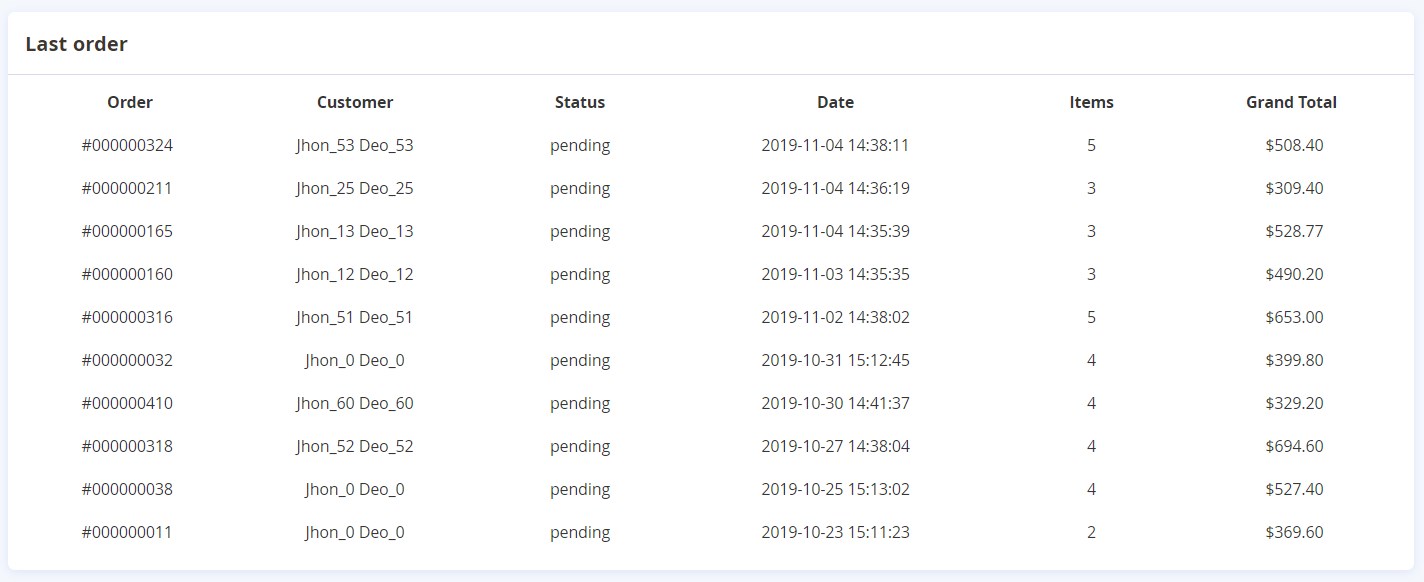
Now, let’s see how the statistics data is represented in the reports generated by the Amasty module.
The Magento 2 Advanced Reports extension allows users to check daily, weekly, monthly, or yearly overview of the total sales. Besides, the Overview graph has a special slider that can be used to set extra time limits within the applied time period.
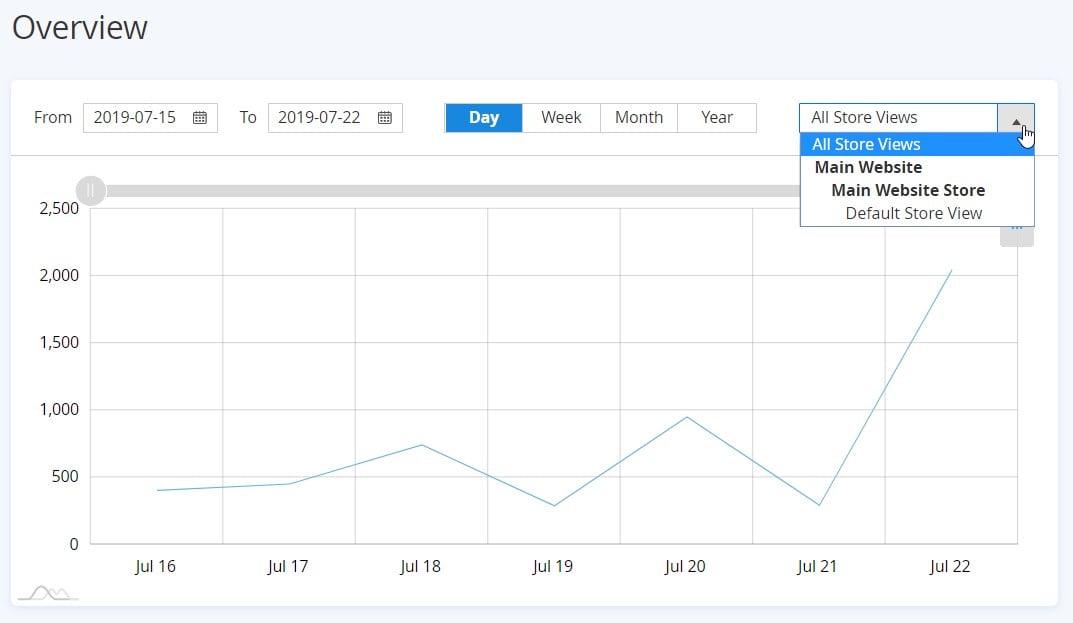
The data is displayed in the graph and grid view. You can control which columns will be displayed on the grid by hiding selected ones. In the last grid row, you can choose how to display the total value of a column, whether as a percentage or number.
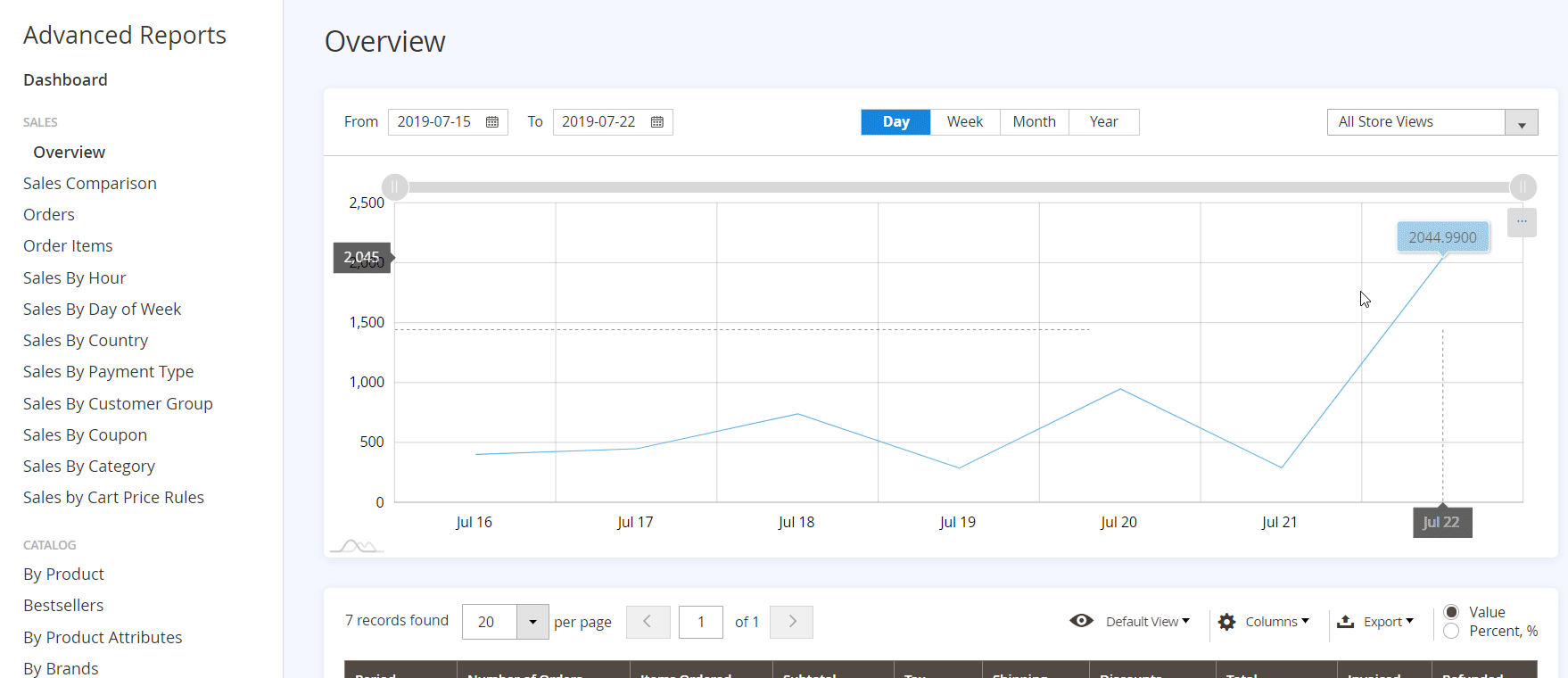
If you want to compare sales statistics for different time intervals, navigate to the Sales Comparison screen.
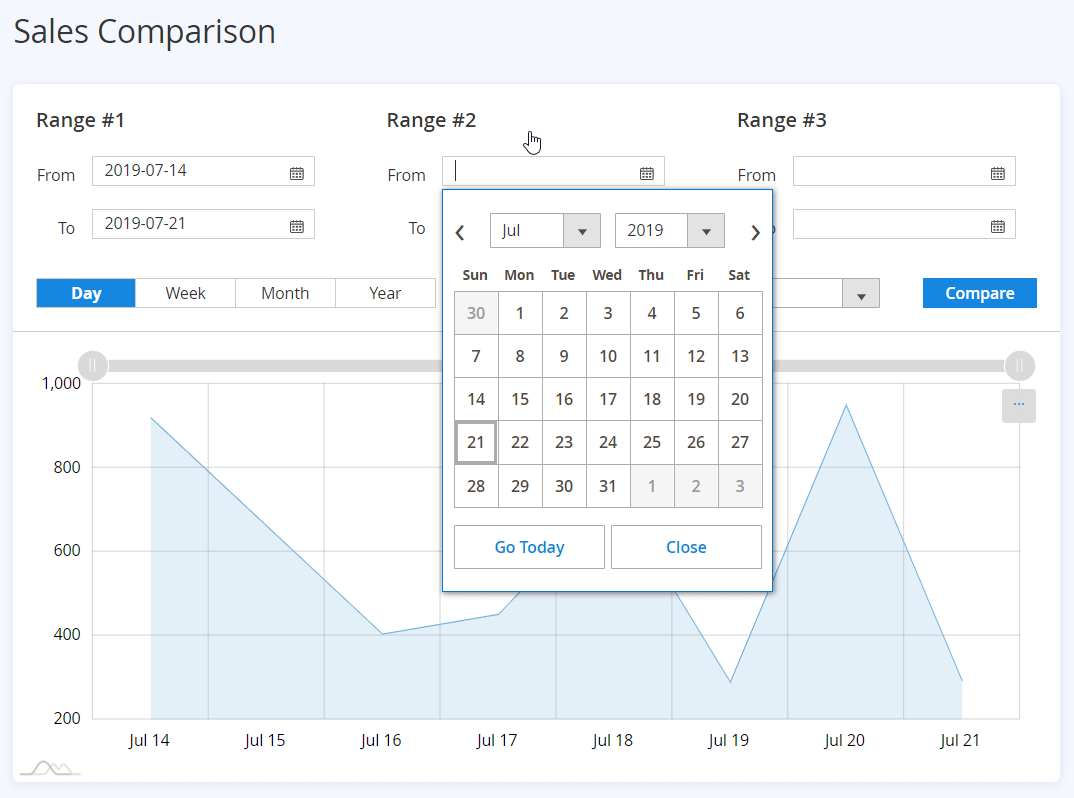
As for the Orders report, here you can filter sales data by the number of sold products (Quantity) and the total amount spent by customers (Total), as well as the order status.
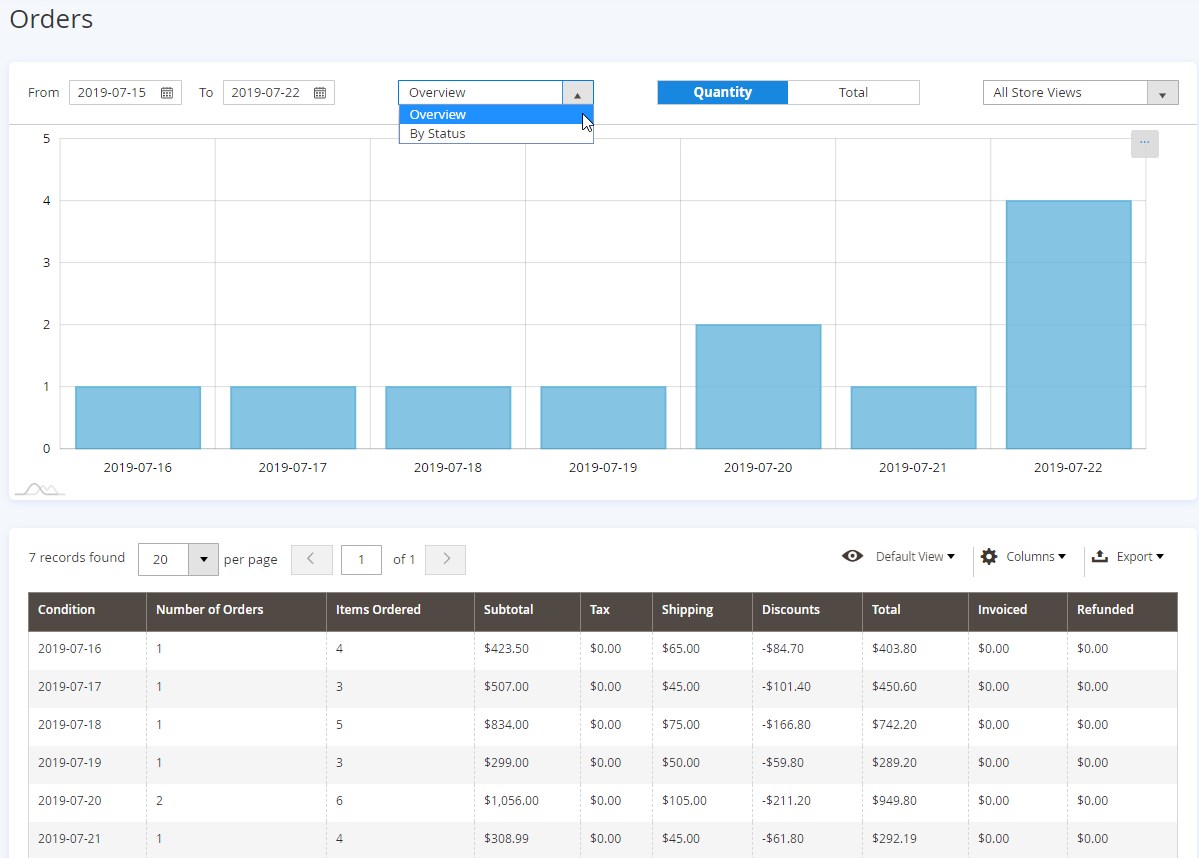
On the Sales by Hour report screen, you can view what hours are the most profitable. All standard tools also work in this section of the Magento 2 reports extension by Amasty.
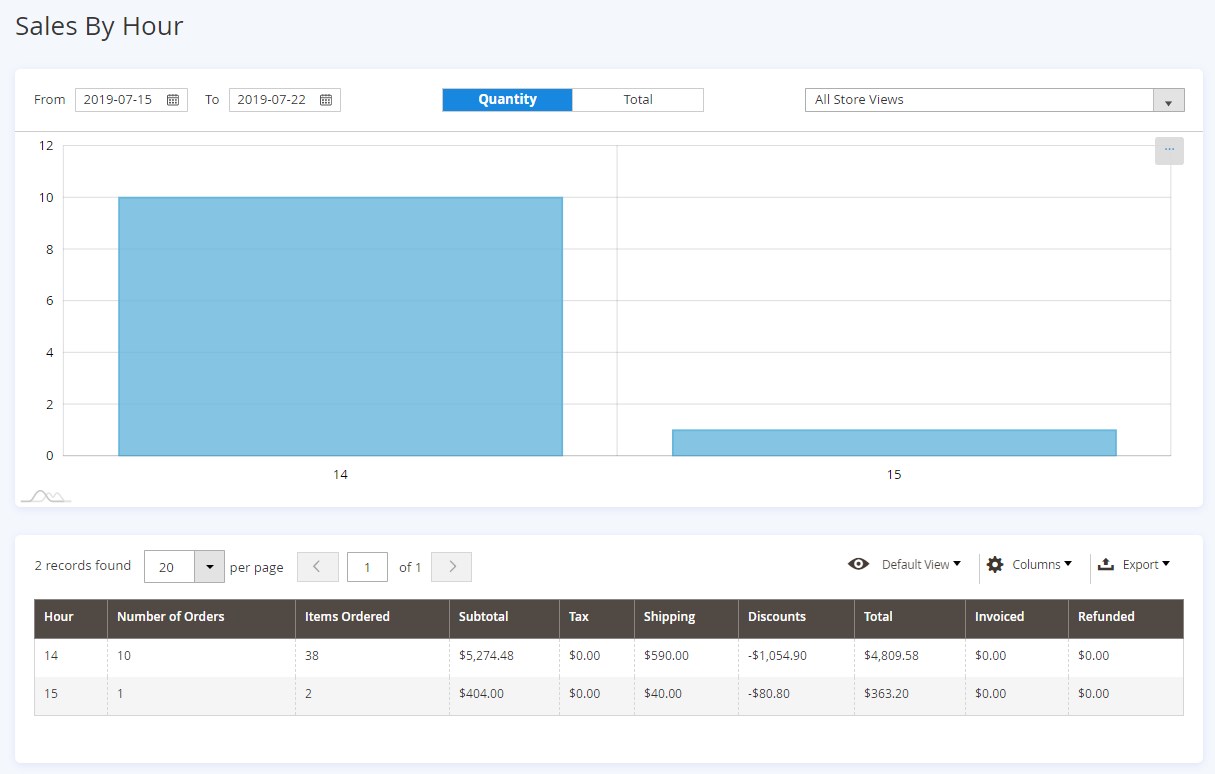
As for Sales by Day of Week, this screen has all the same tools as in the other sections of the Magento 2 reports extension.
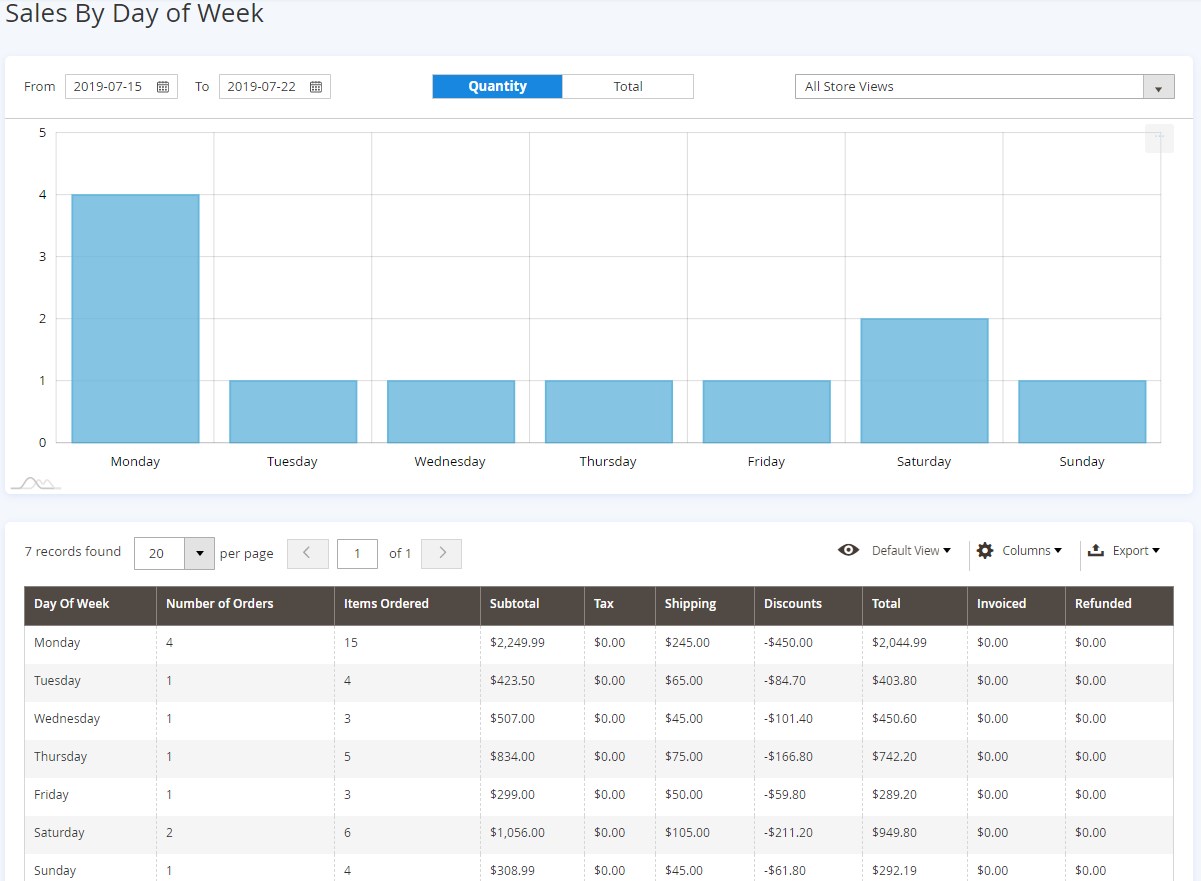
The Sales by Country report consists of a world map and a grid. Both show countries where you sell the most.
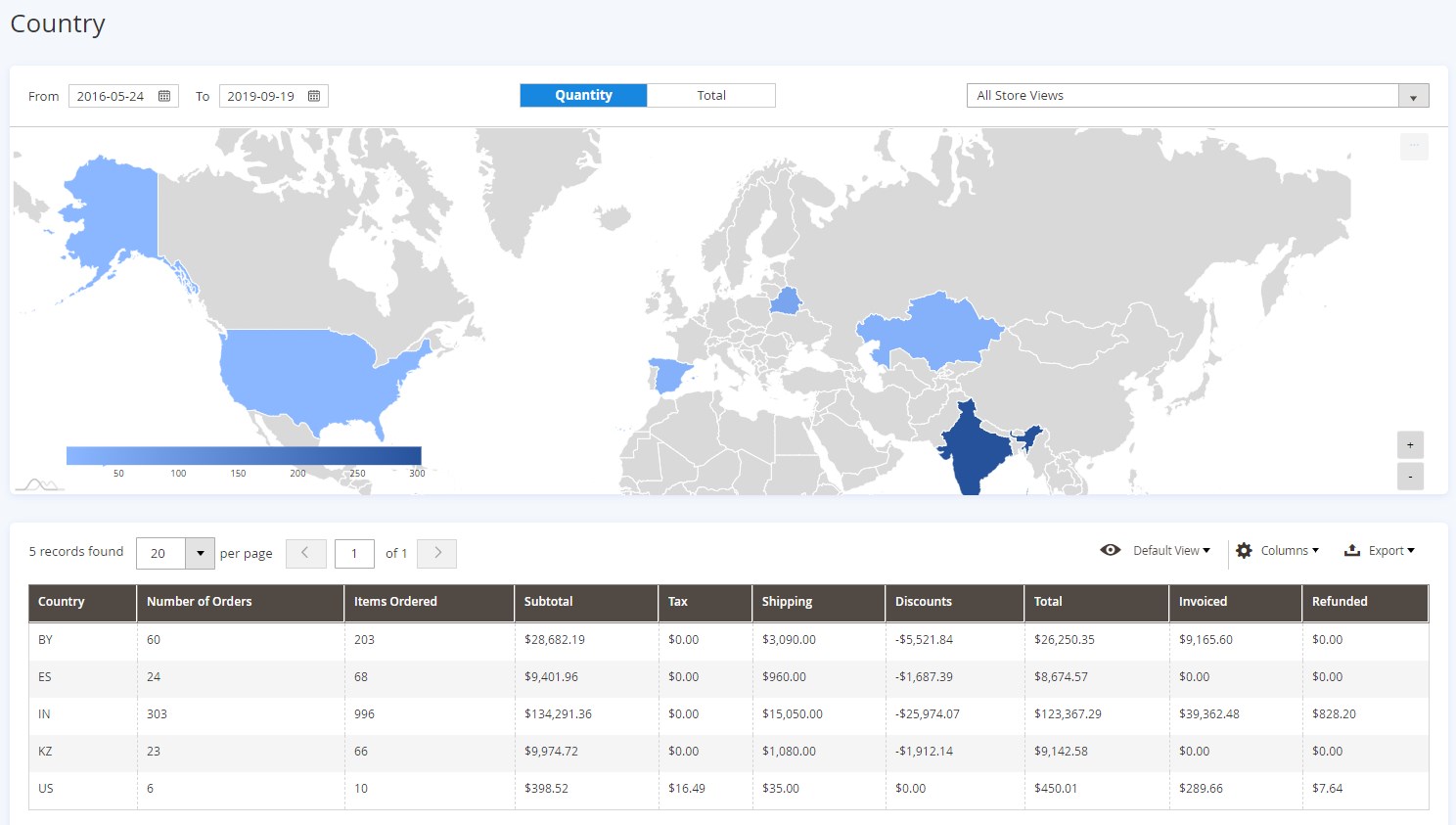
Besides, you can track the sales statistics by state on the Country – State report screen.
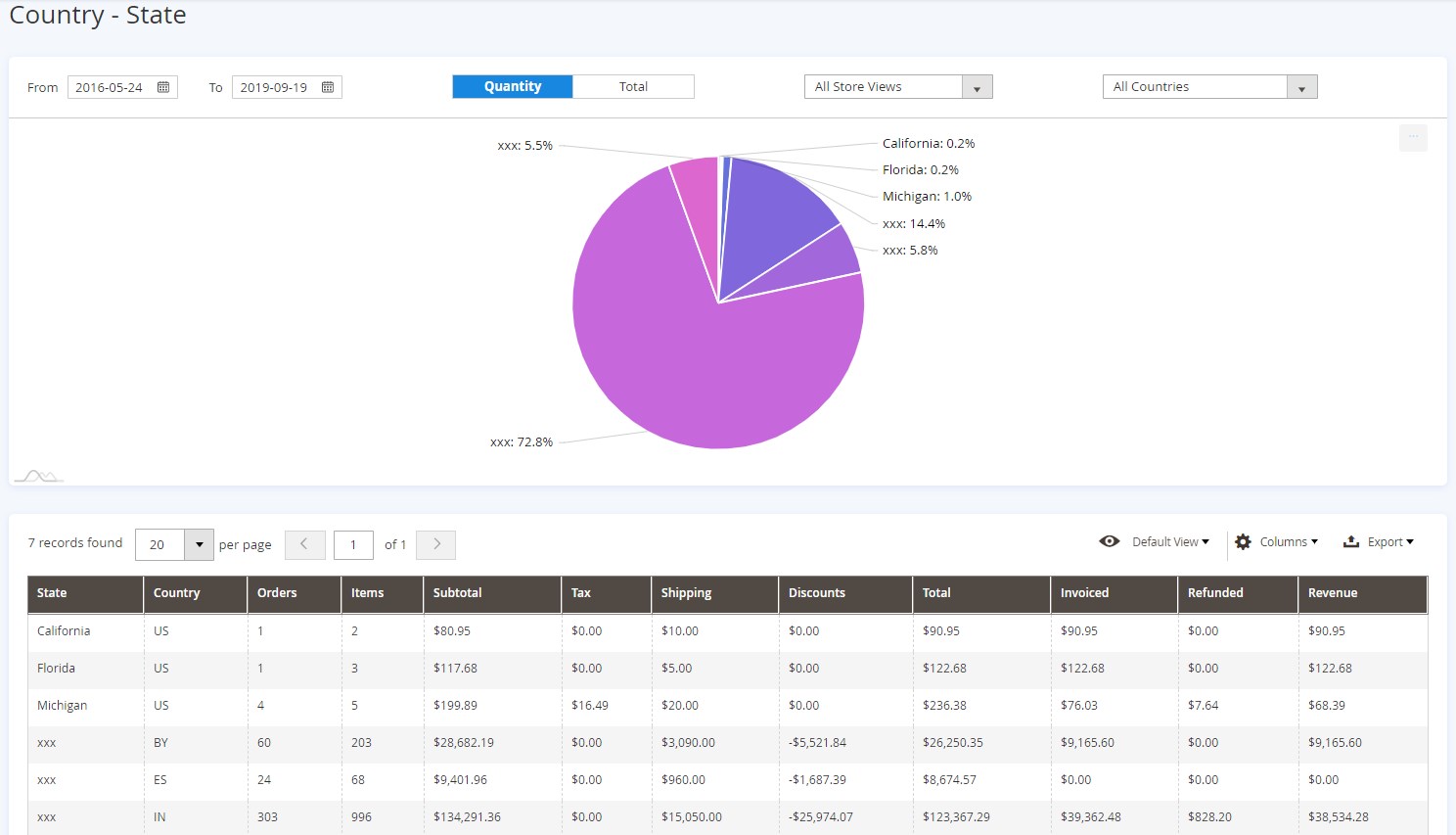
To check what payment types are the most popular among your customers, use the Sales by Payment Type chart. This information can be used for further improvements in your order management.

The Sales by Customer Group report divides all sales data according to the groups of customers. You can use the mentioned before instruments to make the report more precise: set a time interval, use Quantity or Total as a basis for the data display, and choose a store view. All data can be exported, and grid columns can be rearranged and hidden. If you click “Show More” in the Action column, it will forward you to the Sales by Product report filtered for the selected customer group.
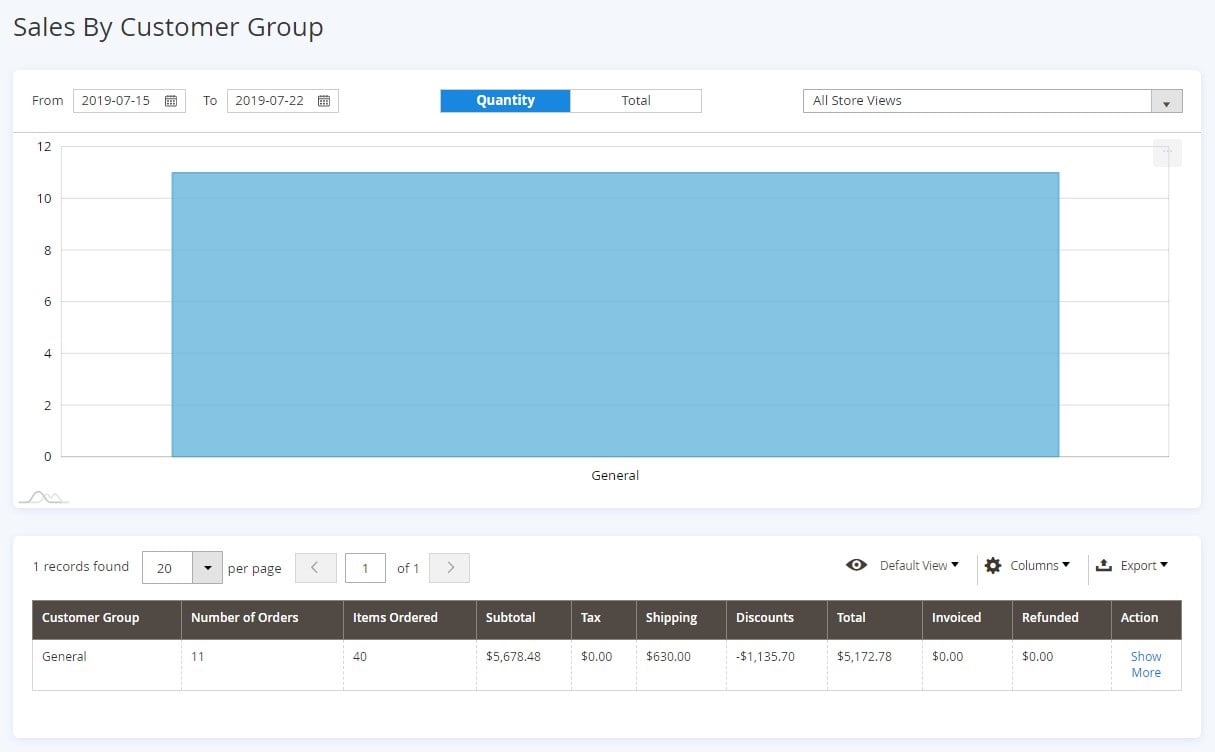
Sales by Coupon report also allows you to set a time period and choose between Quantity and Total ($). Besides, it is possible to filter out results by a store view. All data is available in two forms: diagram and grid.

Sales by Category is another excellent way to find out more about your Magento 2 website. The appropriate page of the Magento 2 reports extension offers a diagram that illustrates what percentage of sales falls on each category. The report page lets you specify a time interval and choose between Quantity and Total as a basis of a diagram. Furthermore, you can view stats on a per store basis. It is also necessary to mention that there is a grid below the diagram that offers more detailed stats on each products group. You can show/hide columns here, as well as export data.
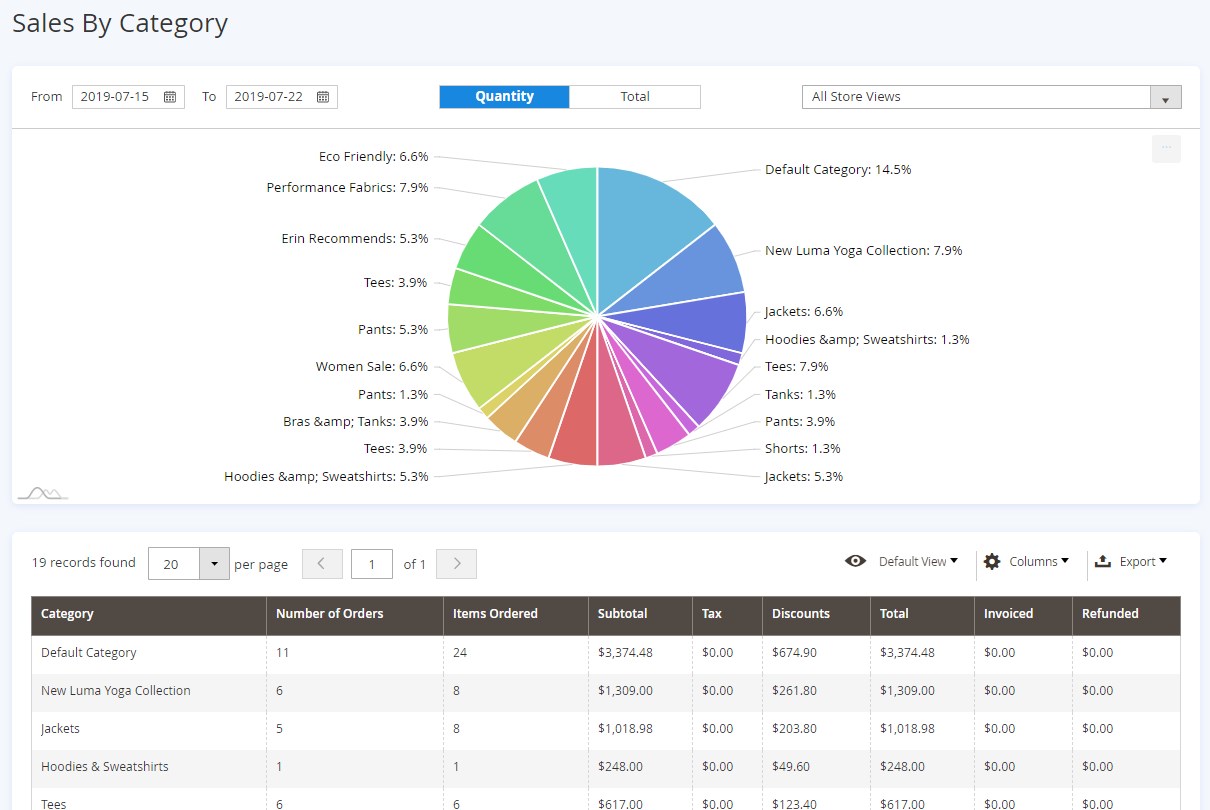
On the Sales by Cart Price Rules chart, you can track the results of your promo campaigns.
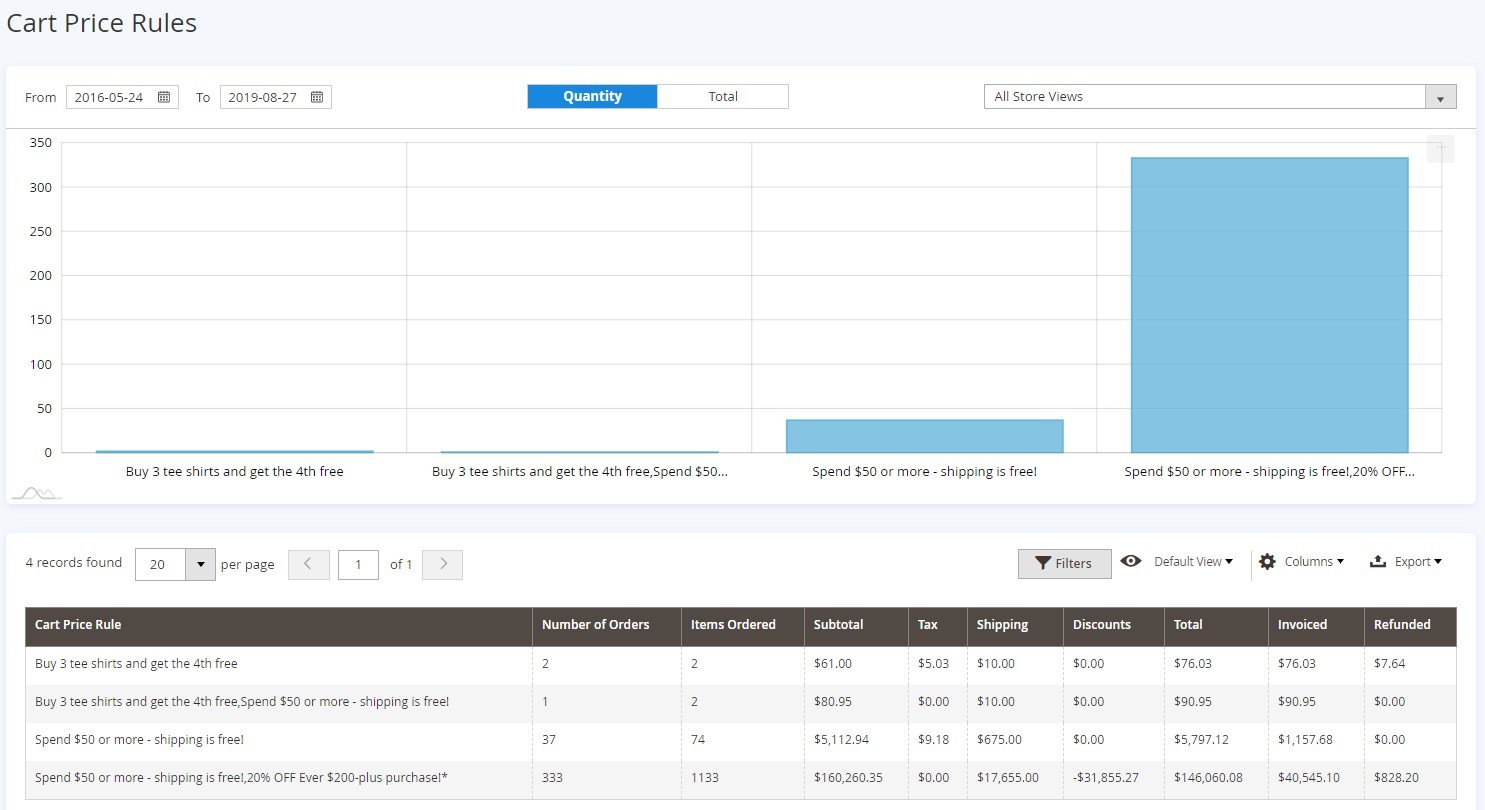
Sales by Product report allows you to keep track of all product sales. The Magento 2 reports extension offers a grid that shows a product SKU, name, the number of sold, ordered, canceled, and refunded products, and the total amount of money spent on them. You can easily customize this grid view by showing/hiding certain columns. Besides, there are three filters on the same page: Customer Group, SKU, and Name. Filtering options let you view the precise data you need.
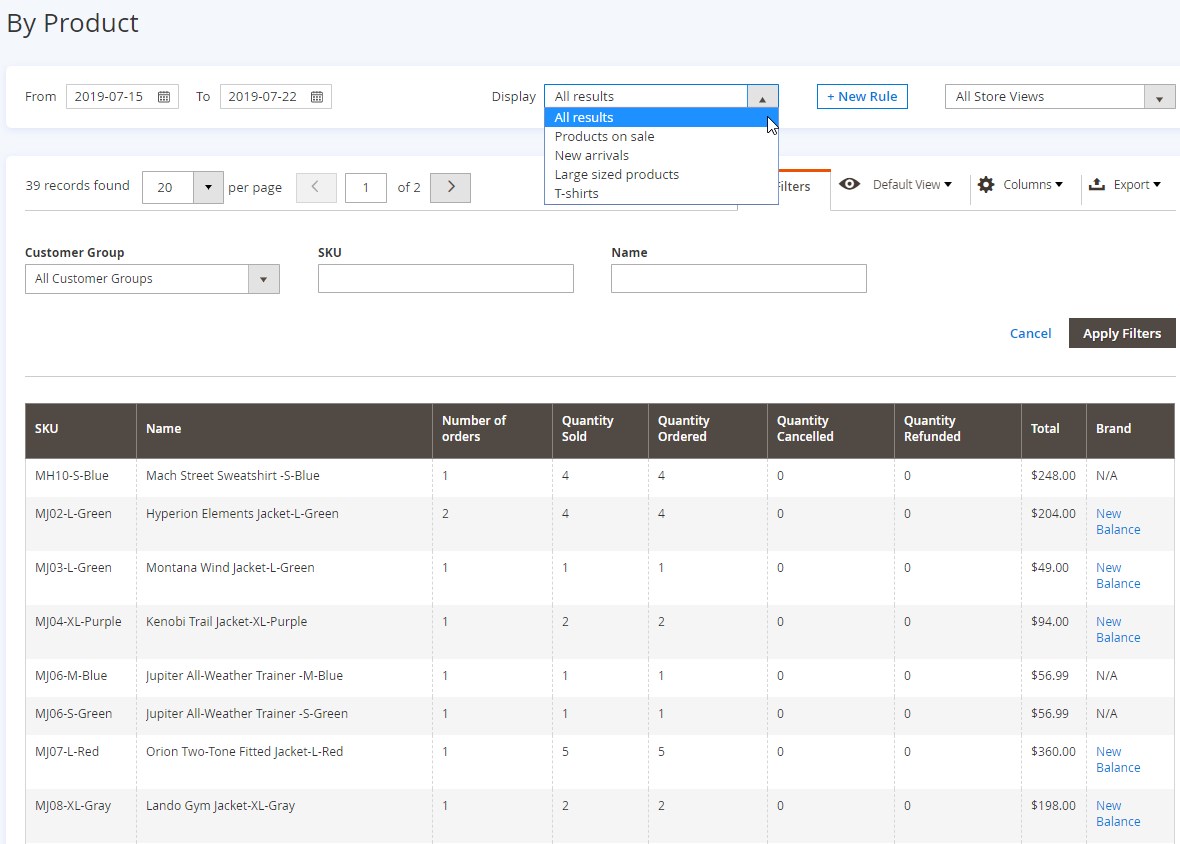
The grid with bestsellers shows your most popular products. At the same time, you can find out which goods are less popular by analyzing the numbers in the Quantity column.
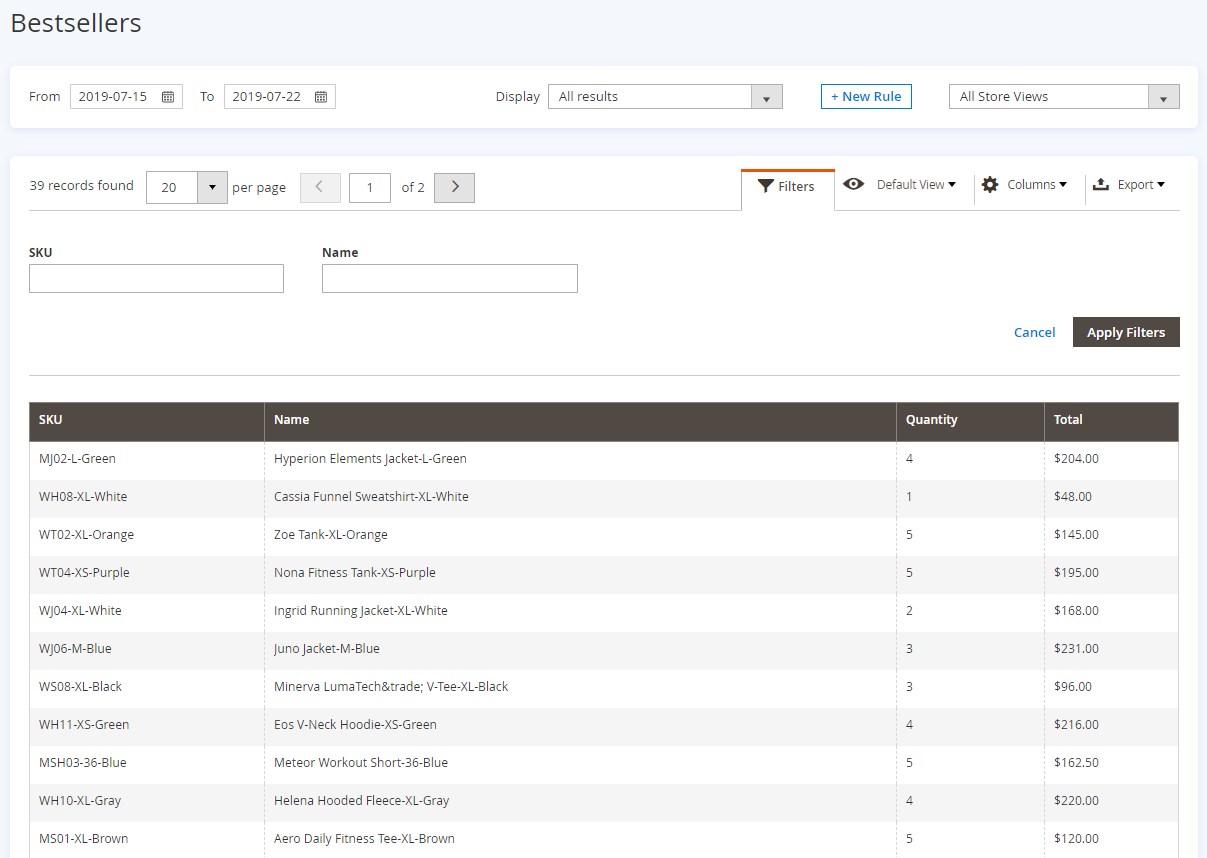
The next report allows you to view order statistics based on product attributes. You can select a particular parameter to generate a diagram and a corresponding table, as well as build it for the attributes set.
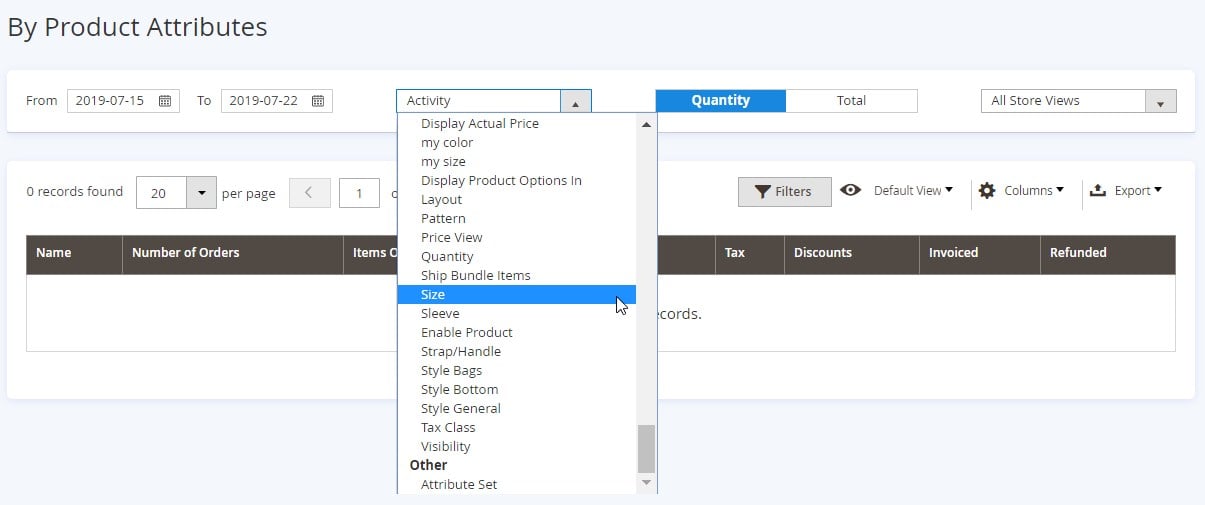
If you are selling products of various brands in your store, the Sales by Brand report will provide useful information for your marketing strategy.
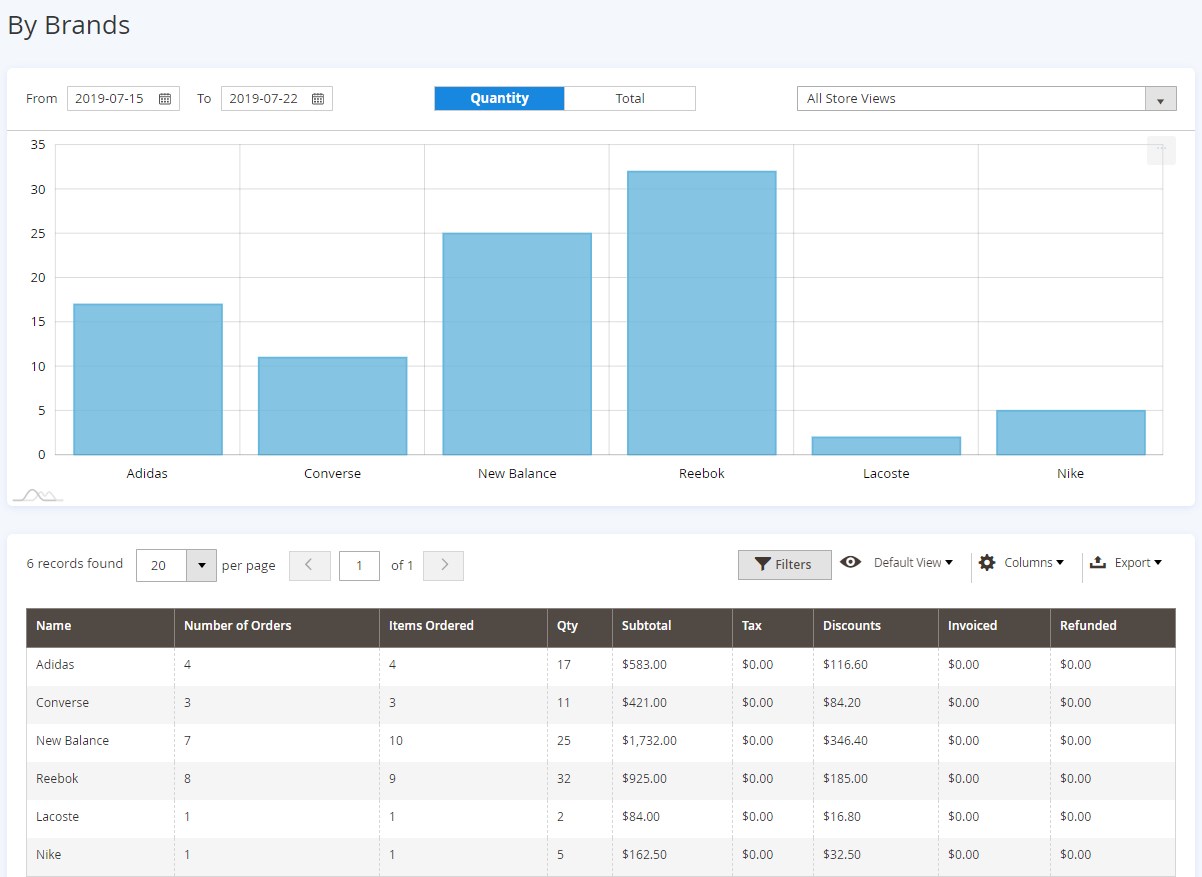
As for the Customers group, it consists of the Sales by Customers, New vs. Returning Customers, Abandoned Carts, and Conversion Rate reports.
On the Customers graph, you can analyze customers’ behavior by checking the number of new accounts registered on your website, as well as the number of orders and product reviews during the specific time interval.

The next report from the Customers group lets you learn the number of new and returning clients and understand the percentage of returning customers during a particular period.
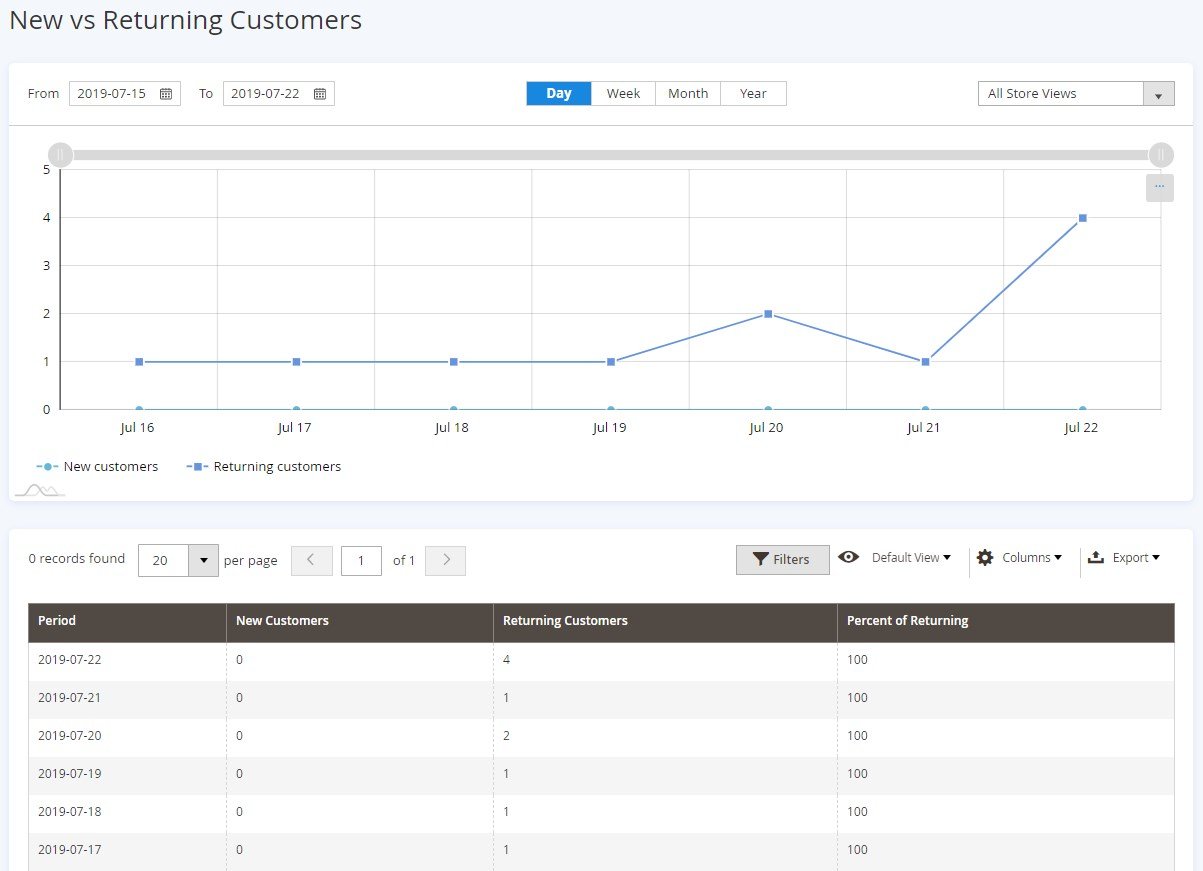
On the Abandoned Carts screen, you can check detailed info on the carts abandoned by customers. It is also possible to send a quote to a particular customer by choosing a corresponding option in the Action column right on the grid. Note that you should have the Amasty Request a Quote extension installed on your store to perform this action.
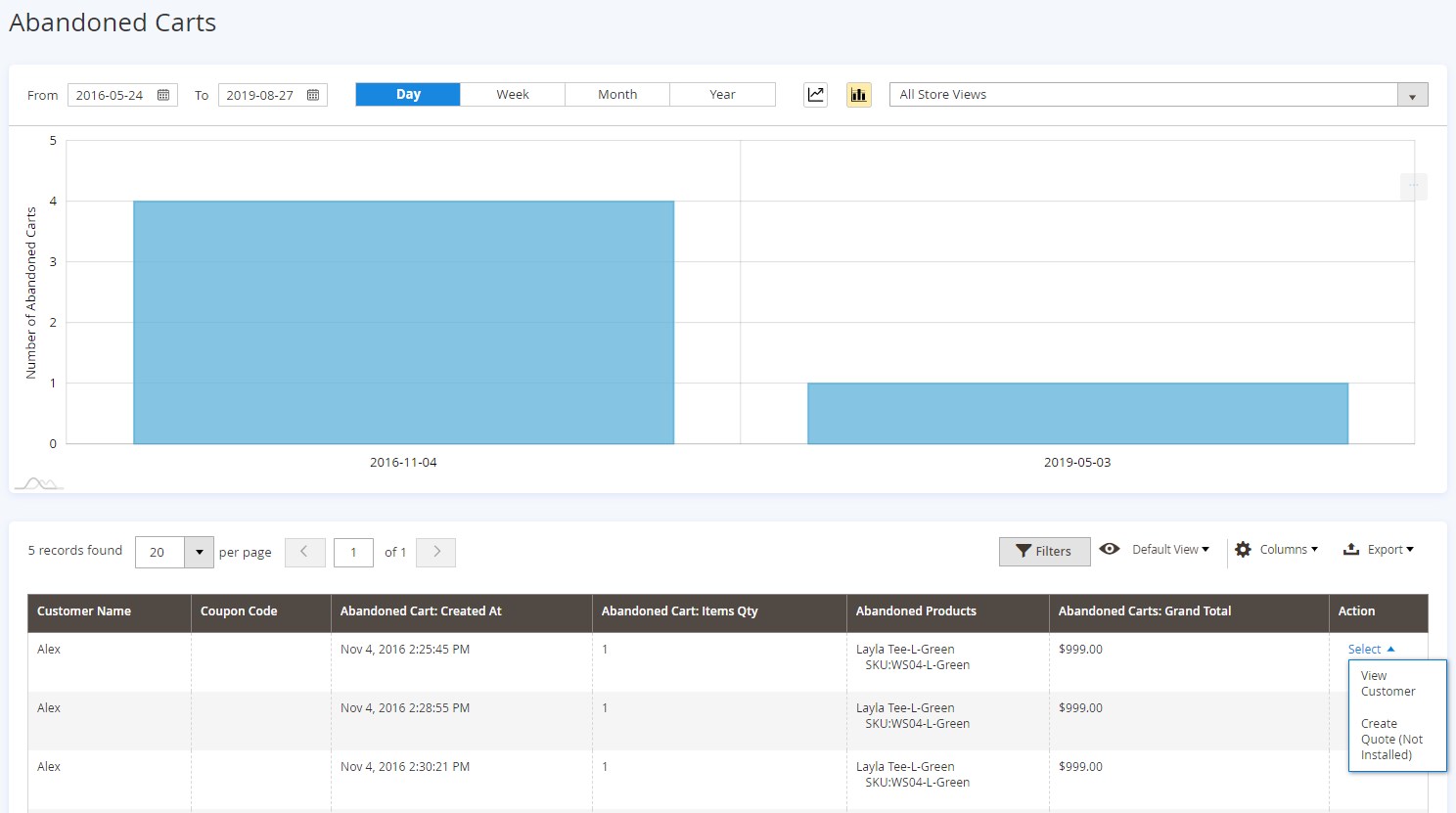
The Conversion Rate report lets you check stats on the conversion rates during different time intervals.
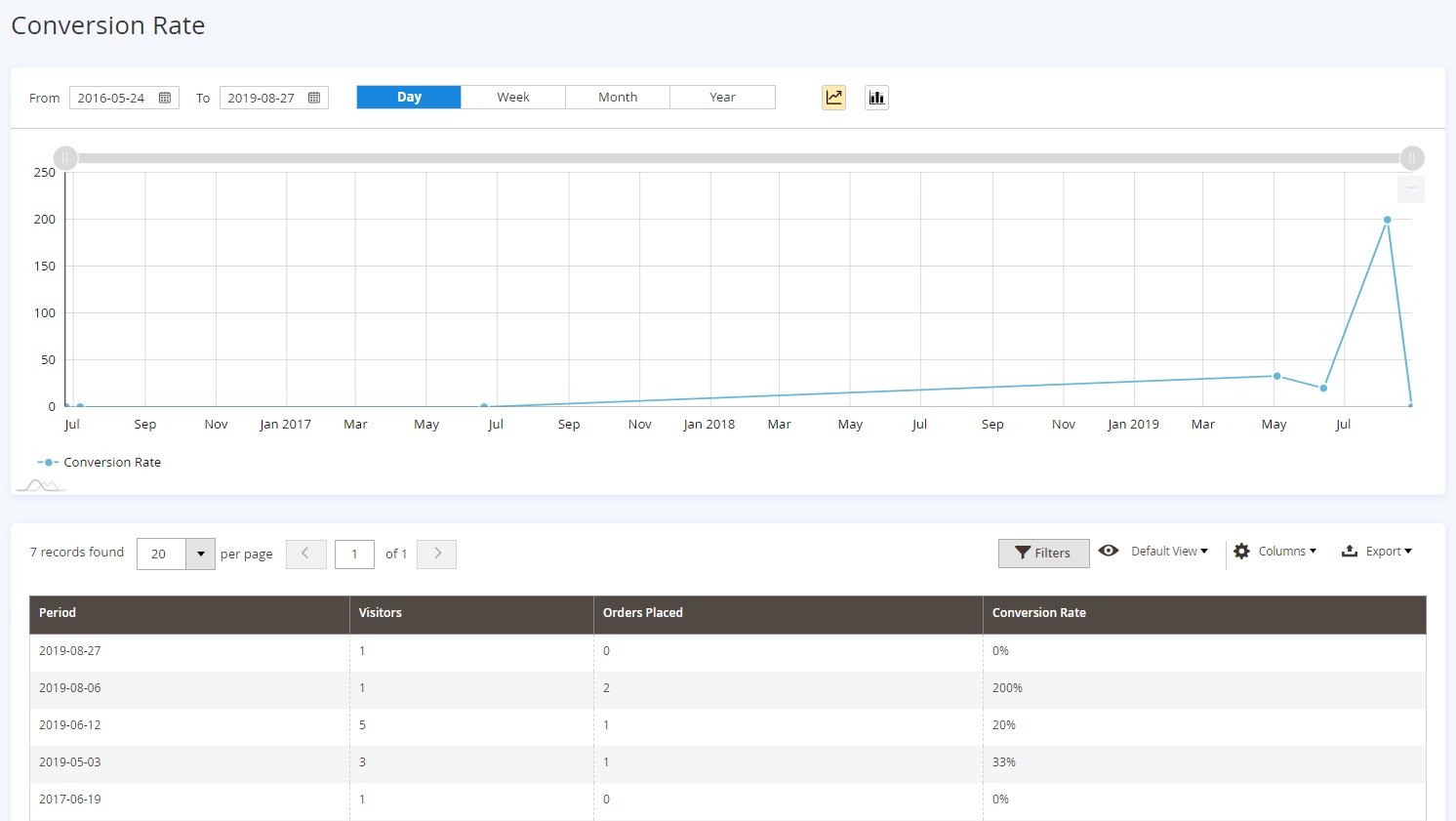
As mentioned above, the Magento 2 Advanced Reports extension allows creating rules for custom reports and apply them for filtering results in the corresponding grid. Admins can view, delete, and edit existing rules, as well as add new rules on the Advanced Reports Rules grid.

When creating a new rule, you will need to specify its title and set conditions based on required product attributes or conditions combination.
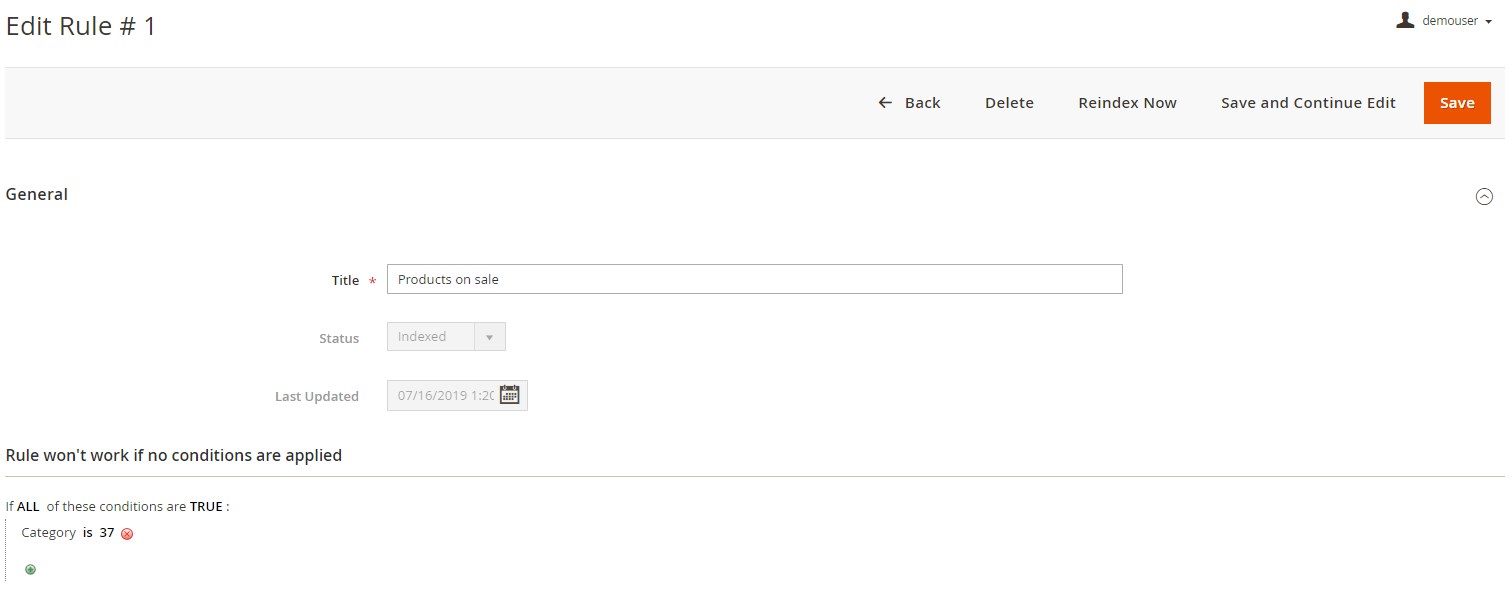
It is possible to generate any number of custom reports based on the created rules and add them to the list of all reports for quick selection.
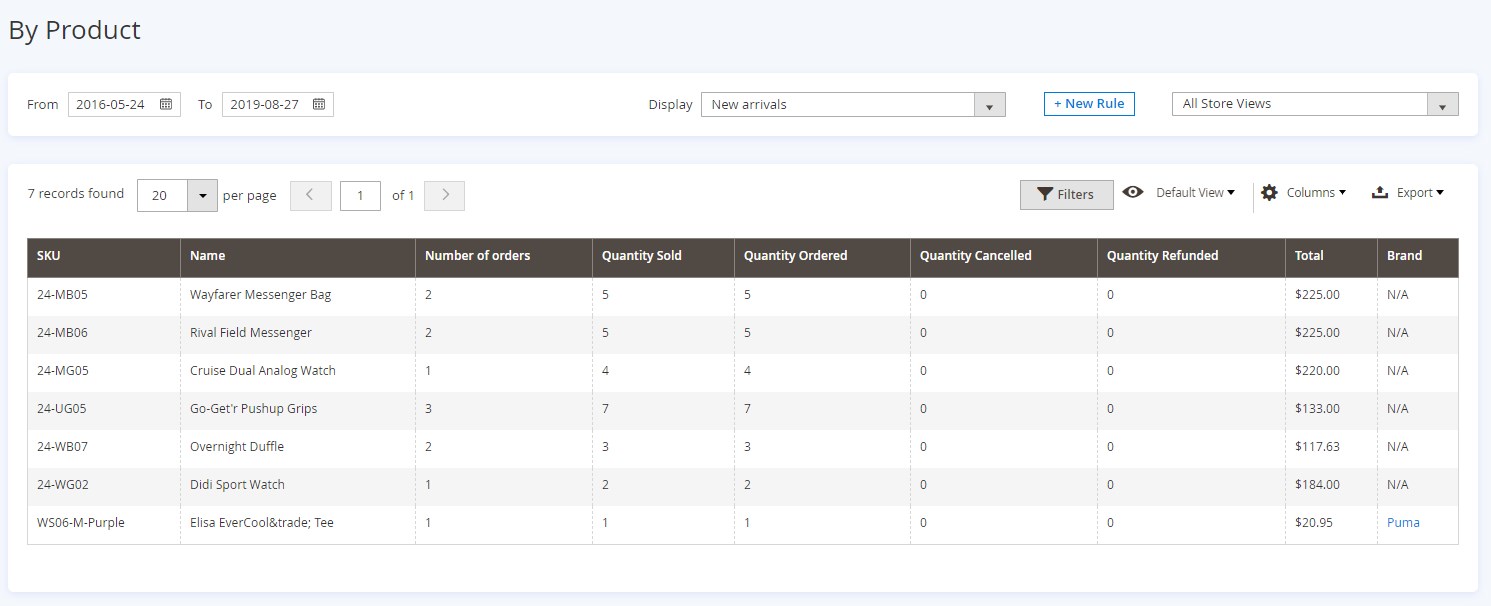
Final Words
As you can see, the Magento 2 Advanced Reports extension by Amasty offers various report types, each of which supports lots of filters to get the most precise data flow. Is this Magento 2 reports module better than its competitors? You can find the answer here: Magento 2 Advanced Reports Comparison. Here, we have only described the functionality of the Amasty’s solution. As for the price of the module, Amasty Advanced Reports for Magento 2 costs $319, while its predecessor has a slightly cheaper price tag – $129.










